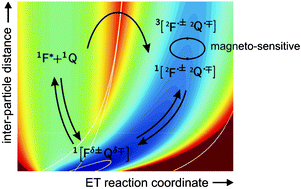Magnetic field effects on exciplex-forming systems: the effect on the locally excited fluorophore and its dependence on free energy
Abstract
This study addresses magnetic field effects in exciplex forming donor–acceptor systems. For moderately exergonic systems, the exciplex and the locally excited fluorophore emission are found to be magneto-sensitive. A previously introduced model attributing this finding to excited state reversibility is confirmed. Systems characterised by a free energy of charge separation up to approximately −0.35 eV are found to exhibit a magnetic field effect on the fluorophore. A simple three-state model of the exciplex is introduced, which uses the reaction distance and the asymmetric electron transfer reaction coordinate as pertinent variables. Comparing the experimental emission band shapes with those predicted by the model, a semi-quantitative picture of the formation of the magnetic field effect is developed based on energy hypersurfaces. The model can also be applied to estimate the indirect contribution of the exchange interaction, even if the perturbative approach fails. The energetic parameters that are essential for the formation of large magnetic field effects on the exciplex are discussed.


 Please wait while we load your content...
Please wait while we load your content...